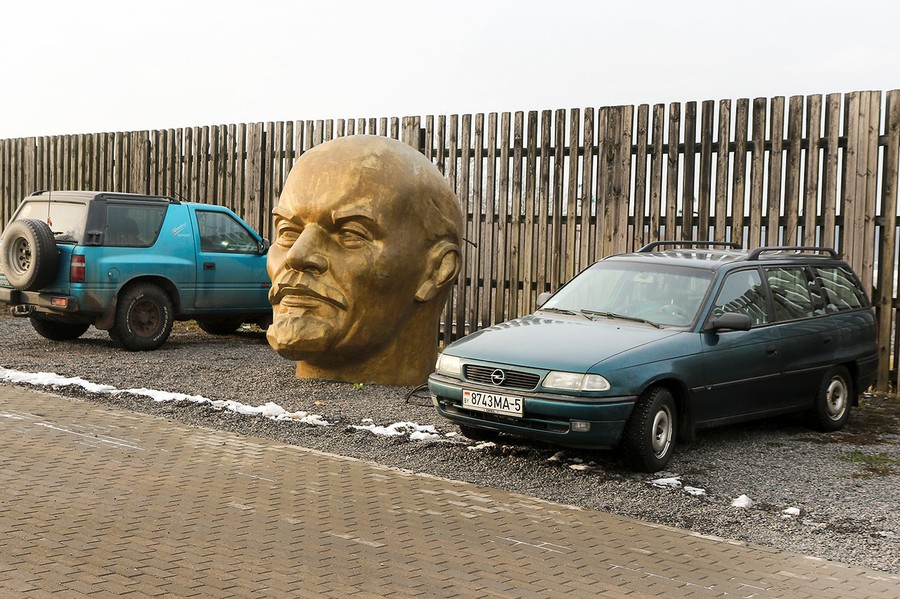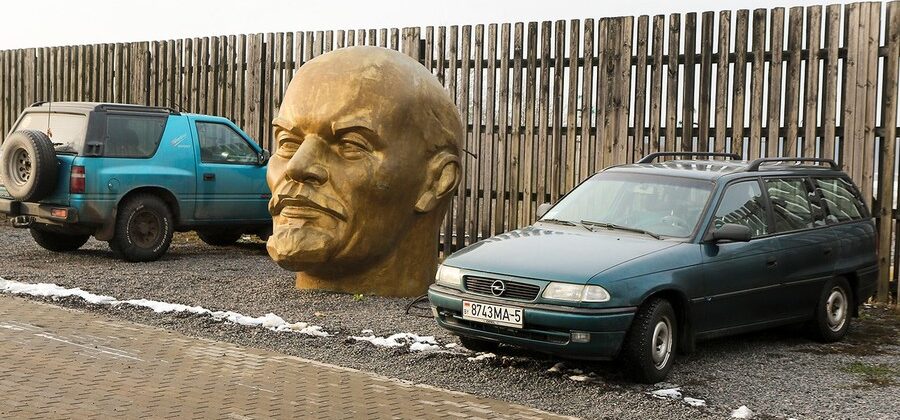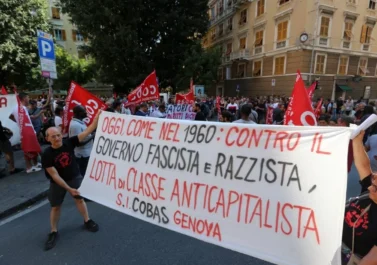
Before we discussed Lenin’s ‘State and Revolution’, our unorthodox reading group went through Chomsky’s ‘Notes on Anarchism’. While we certainly liked the anti-authoritarian spirit, we also saw some of the short-comings of traditional anarchism, with its emphasise on anarchism as a ‘human tendency’ and its view of capitalism as some kind of external centralising force, rather than a contradictory mode of production. While we know about the problems with Lenin, there is still a certain appeal to his thoughts. While many anarchists keep on preaching the good word since 1876 and many self-proclaimed Marxists stare into the headlights of the ‘automatic subject’ or marvel at the ‘value form’, Lenin is all about strategy and tendency, about concrete intervention. That’s another reason why we thought it could be fruitful to go back to ‘State and Revolution’.
We started our discussion by putting ’State and Revolution’ into historical context. When Lenin wrote the text in August and September 1917, after the impressions of the first round of the revolution, he basically wrote against the entire socialist movement, and against his own party in particular. He breaks with party discipline and initially the old guard of the Bolsheviks wanted to suppress the publication, given its radical impetus: the insisting on having to smash the bourgeois state apparatus. We can see the significant contribution of ’State and Revolution’ for the subsequent events. This is also a partial answer to the question whether Lenin actually contributed anything new, or whether he was just re-phrasing Marx and Engels or even distorting them. His theoretical contribution lies in the fact that it was a strategic intervention at a certain historical juncture, in close relation what workers did in 1917. In this sense there is still something to learn from the text, as Chile 1973 or even Argentina 2011 shows.
We then asked ourselves to which extent ’State and Revolution’ is just an opportunist text. It differs a lot from what Lenin wrote on question before and, more importantly, what he himself propagated only a year after he wrote the text, e.g. the need for a standing army, the enforcement of state power against the councils. Was it opportunist in the sense that he wanted to get ahead of what workers were doing at the time, e.g. confronting not just the Tsarist police, but bourgeois power in general? At this point of the discussion we diverted from the original text and had a back and forth whether the outcome of the Russian Revolution was just ‘externally’ tragic, in the sense that the working class in Russia was subjectively strong, but objectively weak and that the absence of an international revolution meant that the Bolsheviks had little scope to implement anything else but a state capitalist development; or whether there were fundamental strategical decisions made by the Bolsheviks, which took the life-blood out of the revolution: one-man-management rather than council power; standing army rather than workers’ militia; land to the tiller rather than collectivisation; national independence rather than workers’ internationalism (see Luxemburg). The revolution might have lost, if German or English (proletarian) soldiers would not have fraternised with ‘emancipated’ workers who defended their means of production, but it would not have created a monster in the name of workers’ emancipation.
We then raised the question whether there are indicators in the text that Lenin’s understanding of ’smashing the state’ itself was limited. In the text he presents the state primarily as an ‘armed force to sustain class rule’, as a bureaucratic machine. He writes less about the role the state has in maintaining the capitalist social division of labour by being part of social labour, not just by brute force. This aspect might not have been too developed in Russia 1917, but to neglect this aspect could mean that ’smashing the state’ is understood as coup or disarmament of the armed wing, rather than a deeper social transformation. The thought, for example, that you could have a ‘red’ standing army, without its social implication, e.g. increased exploitation in the factory, re-emergence of military hierarchy etc. speaks in favour of a position that sees ’State and Revolution’ as a partially opportunistic, partially voluntaristic text. On top of this some of us felt that he not only misrepresented anarchist currents in his text, but also Marx himself.
We then returned to the fact that hardly anyone was really able to draw the lessons from 1905 (first revolutionary upheaval), 1914 (collaboration of the official labour movement with the capitalist warring powers) and 1917 (workers’ revolutionary power) in a strategic sense. To quote Tronti, we started by saying: “Lenin!”; and ended by saying: ”Yeah, but…”. From Chile 1973 to Italy in 1969 to 1977 – the relation between working class struggle, workers’ control over the productive apparatus and the need to smash the state in a concerted effort is still a contested territory…
Our next reading will be Victor Serge’s ‘Memoirs of a Revolutionary’, feel free to join in!
———
In the run-up of the discussion a comrade circulated these thoughts, in order to provide some context. They are useful, so we share them here:
“Having revisited State and Revolution after many years I’ve been reminded of the many useful insights that it contains. Hopefully we can tease out some of these in the session. However, to fully appreciate S and R, as with all revolutionary texts, we have to try and get an understanding of its “place in history”.
To mummify Lenin as the Stalinists did physically and the Trotskyists (self styled Bolshevik-Leninists) and Maoists (Marxist-Leninists) did politically is not the approach of thinking revolutionaries. Neither, and I would hope to find common ground with most Angrys here, should we find nothing positive In Lenin’s work because of the history of Russia/Soviet Union after 1921. Of course, we can argue about what year marks the real rupture but there seems to be a pretty strong case for the year that includes Kronstadt and the start of NEP (the New Economic Policy that encouraged the rebirth of officially sanctioned petty proprietor capitalism and the enrichment of the kulaks/”rich peasants”). The recognition of the positive contributions of Lenin and other revolutionaries who realigned particularly in the period between 1914 (the start of the First World War) and 1920 (the Second Congress of the Third International/Comintern) is a markedly different position than that of the Anarchists or SPGB.
During the 1890s and first 14 years of the 20th Century the Second International and the “Social Democratic” movement (see Lenin’s comments on both the name and the politics) developed a mass movement in most parts of the advanced capitalist nations as the World Economy and Imperialism established themselves. As S+R describes, the Soc Dem project based on Trade Unions and parliamentary parties involved millions of workers in a mass movement which proved to be fully compatible with the exploitative capitalist order. The prevailing attitude of “passive radicalism” and “a theory of inactive expectancy” [Pannekoek’s 1912 response to Kautsky referred to in S+R chapter 6, Part 3] did not go unchallenged.
Lenin played a part in the revolutionary challenge to Second Internationalist Orthodoxy and an increasingly significant one as socialists had to relate to the political collapse in 1914, the need to remould a revolutionary proletarian “praxis” following that and the revolutionary wave of mutinies, strikes, occupations and revolutions that ended the First World War and briefly challenged the late capitalist/imperialist world order. Although Lenin and other Bolsheviks had sown many seeds in the Russian working class before 1917 they were far from alone amongst those who defended revolutionary perspectives.
In Chapter 6, Part 3 Lenin refers to Anton Pannekoek, Rosa Luxemburg, Karl Radek and other “Left radical”s who had argued for alternatives to the Second International’s reformist direction. Before 1914 that movement included the Dutch “Tribune Group” and the Bremen left in Germany. In USA, De Leon’s Socialist Labor Party (and its sister parties elsewhere) and the early IWW were different expressions of revolutionary proletarian positions. Needless to say, revolutionary Marxists can only develop and become meaningful as a result of the “real movement” of the class. Crucially, for that period in the early years of the 20th century the Russian working class provided the living experience for the revolutionary minority to learn from.
During the late 19th century Lenin and others including Plekhanov, Zasulich and Martov had supported the birth of Social Democracy in Russia. That was a crucial development recognising that the perspective of Russia moving directly from the peasant commune to a “new society” was no longer a valid perspective. The spread of capitalism would not and did not halt at the boundaries of the Tsarist “prison house of nations”. Unlike the previous generations of Russian revolutionaries the RussianSDLP (after 1903, containing two tendencies, Menshevik and Bolshevik) struggled not with whether but how the industrial proletariat would carry out a revolutionary role.
The 1905 revolution was to provide a template for revolutionaries to understand many aspects of the nature of proletarian revolution at that stage of imperialist development. One vital development was the emergence of Workers Councils/Soviets as unified working class organisations. Initially the Councils exist as a vehicle for struggle within capitalism but rapidly they become the vital organs for a revolutionary reconstitution of society – control by the working-class. Their birth and development depends on the class’s self organisation. The two aspects, a living dialectic of unfolding class struggle, were most sharply understood by two non-Bolshevik revolutionaries. The potential for working class political power and the role of the Councils was analysed in Trotsky’s “Results and Prospects” written in 1906.In the same year, Luxemburg analysed the Revolution and analysed the role of the class organising in its own interests in “The Mass Strike”.
From August 1914 onwards, Lenin played a major role in supporting the reemergence of a revolutionary fraction. His advocacy of “turning the imperialist war into a civil war” rather than any variety of social pacifism was crucial to the solidifying of an international and internationalist left-wing in the conferences at Zimmerwald and Kienthal (1915 and 1916 respectively). By 1917, the work carried out by the revolutionary minority had already explained the historic stage and the choices facing humanity. The works by Lenin, Bukharin and Luxemburg had explained the transformation of capitalism into Imperialism, a global system of “state monopoly capitalism”, described by Lenin as “the highest stage of capitalism” – an epoch of wars and revolutions. For Luxemburg the First World War had written in blood the question of “Socialism or Barbarism”.
That work though had not, and could not, draw conclusions that would be needed and could only be crystallised in response to class struggle. As the working class began to regain their combativity with organising in communities and workplaces and as rumbling mutinies broke out the imperialist chain “broke at its weakest link”. The end of Tsardom, accompanied by the fresh emergence of Soviets and desertions and mutinies from the army and navy posed vital questions for erstwhile socialists in Russia. In March 1917, the view of the “Old Bolsheviks” in Russia was that the programme of the “Democratic Dictatorship of the Workers and Peasantry” effectively meant that that those classes needed to curtail their aspirations and allow capitalist normalisation to to grow out of the ruins of Tsarism. The revolutionary minority, as described previously, understood that the capitalist norm, in Russia or anywhere else, could only mean ongoing exploitation, misery and war. Two works by Lenin, “The April Theses” and later “S and R” provided essential stepping stones to allow revolutionaries to intersect with the other most active and class conscious workers to prepare the way for the second Congress of Soviets in October/November (depending on the calendar) to declare an end to the Provisional Government and the taking of “All Power to the Soviets” – the conscious first step towards the global ending of capitalist power.
The October revolution was a beacon to the advanced sections of the working class across the world. Empires were overthrown, mutinies, strikes and occupations broke out as the four year long butchery of the capitalists’ “Great War” could no longer continue. The first wave of the German revolution was drowned in blood with the full connivance of the Social Democrat political leaders but Soviet republics were formed and existed briefly in Bavaria and Hungary. In North America the Winnipeg Mutiny spread across Western Canada, Soviets appeared in Cork and Limerick (put down by the early IRA) and the red years of occupations and struggles broke out in Italy.The First Congress of the Comintern was held in Moscow in 1919 but was attended by only a limited representation from the global class that was in ferment. The easier access to Moscow in 1920 allowed a much wider attendance that still reflected a revolutionary minority committed to world revolution.
The next revolutionary wave will not look like 1917-21. Only foolish day dreamers imagine a Provisional Government being tipped out of a Winter Palace by a 21st century Military Revolutionary Committee ready for the Congress of Soviets to take power the next day. On the other hand, those who reject our class’s historic struggles and instead hold onto illusions in Social Democratic/Parliamentary/Trade Union paths to power provide only confusion to our class and comfort to our enemies.”



